| |
|
|
| |
We need some of the wet stuff.
Thu 4th July, 2013
|
|
|
|
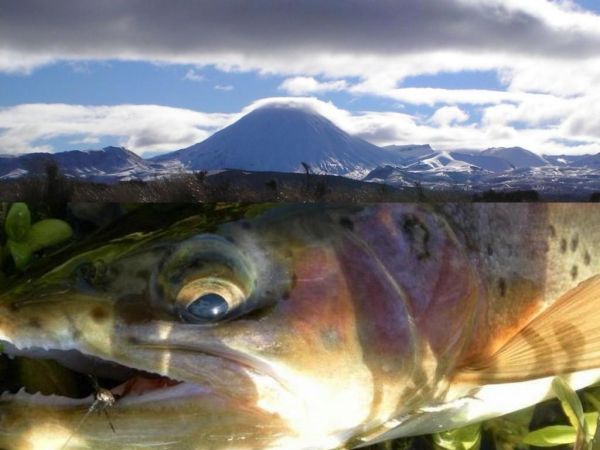 Whenever I get to the Desert road on my " commute " North I'm always impressed with the rugged landscape laid out before me. It doesn't matter how many times I see them, the snow covered volcanoes of the Central Plateau are quite a sight. Looking at them glistening in the winter sunshine I can't help thinking how lucky I am to live in such a beautiful country. They also remind me that I'm less than an hour away from my destination and another few days fishing the Tongariro river. But this time it wasn't going to be just a fishing trip. Whenever I get to the Desert road on my " commute " North I'm always impressed with the rugged landscape laid out before me. It doesn't matter how many times I see them, the snow covered volcanoes of the Central Plateau are quite a sight. Looking at them glistening in the winter sunshine I can't help thinking how lucky I am to live in such a beautiful country. They also remind me that I'm less than an hour away from my destination and another few days fishing the Tongariro river. But this time it wasn't going to be just a fishing trip.
I probably spend around a third of my life in Turangi and now that Gail has discovered the ski slopes at Whakapapa and Ohakune we spend more time here than ever. After years of relying on motel owner mates at TRM and the Bridge Motel it was time to find a place of our own ... before they realize I haven't paid my bill or bar tab! So when "Eddie the eagle" joins me in a couple of days the hunt for our retirement bach will begin in earnest.
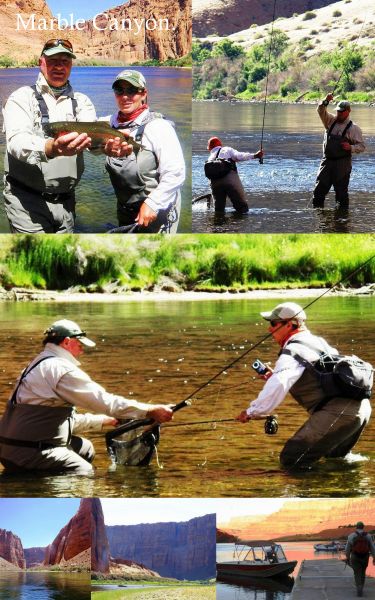
When Mark Tomsett retired a couple of years ago it was actually his wife who suggested he took up fly fishing ... anything ... pleeeeease!
Mark is now a regular face on the Tongariro and just to keep Sarah happy gets out from under her feet whenever he can. He even went out of his way to organize a session or two on a recent family holiday to America.
Part of their trip included a must see visit to the Grand Canyon. So before they flew out he secretly arranged a wonderful surprise for Sarah ... and booked himself a guide to show him the ropes on the Colorado River!
You can see Mark on the left fishing with his guide Natalie Jensen from Lees Ferry Anglers www.leesferry.com. They're on a stretch of the river known as Marble Canyon which is in northern Arizona and marks the beginning of the Grand Canyon and the western most land boundary of the Navajo Indian Nation.
They use various methods in this spectacular location but Mark reports he had great fun fishing " two tiny midges tied on barbless hooks with a shot 2ft above them.
These were fished under a double indicator consisting of two foam pads 6 inches apart "
... looks like it worked too.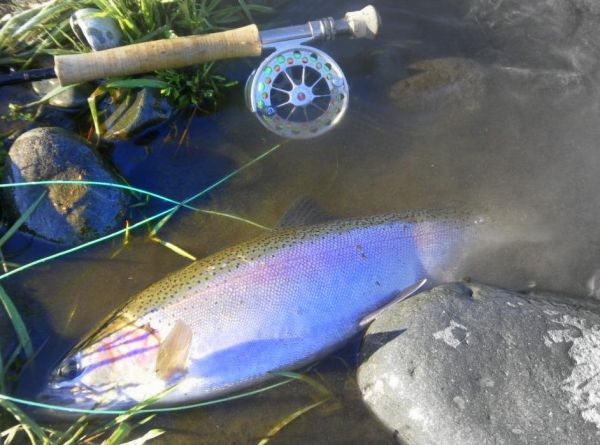
Like many other Tongariro fly fishermen Mark enjoys nymphing and like others who consistently catch fish on the river has learned it pays to fish your flies deep ... particularly during the spawning runs.
In the warmer months when there's plenty of insect activity above and below the surface, fish can be found throughout the water column. Of course it depends on what's hatching or falling into the river at the time but even then most of their day is spent near the bottom where the water is cooler and the flows are less.
As winter takes hold nearly all of their food will be on or close to the bed of the river and consist mainly of caddis larvae, nymphs and fish eggs found under or amongst the rocks and gravel.
But food isn't the only reason they're down deep. Trout entering the river to spawn instinctively know how to conserve energy for the task ahead. As they travel upstream they stay close to the bottom where friction slows the water as it passes over the riverbed. During the bigger runs you will occasionally see some of the fish " porpoising " as they pass by. But no one seems to know why they do this and I just call them happy trout.
I'm sure you can tell where we're going with this. And already understand how important it is to get those flies down and keep them there as long as possible ... especially in winter ... because that's where the fish will be.
If you are a beginner or a visitor and the anglers around you are catching and you're not, your lack of success is probably due to the fact that your flies are not sinking fast enough or staying deep enough to reach the fish.
When your nymphing with an indicator the obvious way to achieve this is with a combination of good line control { mending } and weight, either in the form of a heavy tungsten bead fly { the bomb } with your natural or globug attached to a dropper off the bend. Or by dispensing with the bomb altogether and pinching a couple of split shot onto the line above your flies.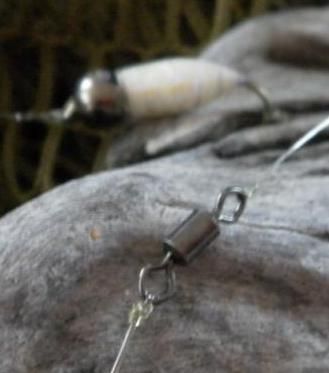
You could also try using bombs or nymphs coated in epoxy which will cut through the water and sink more quickly than heavily dressed patterns. Give some thought to your leader as well because every little helps. If you've never been on the river before then you will probably have been reading up before you ventured out. So you'll know that all good fly fishing leaders are tapered ... that is until you have to fish deep in a fairly fast flowing river with a heavy weight on the end of it.
The two most common types you'll come across are commercially manufactured knotless tapered leaders. Or compound tapered leaders which are made by joining together successively thinner level lengths of mono.
You can either buy compound leaders or make them yourself.
This is where it gets complicated if your just starting out but don't panic because as you'll see you don't need a traditional leader when fishing heavy flies on the Tongariro.
A " normal " fly fishing leader has to perform some very important tasks which help the fly fisherman.
As we cast it aids the transfer of energy from the fly-line to " turn over " the flies so that they land quietly onto the surface. This is the first bit that goes out the window when you fish weight.
The leader should allow a less visible link between the thick easily seen fly-line and the fly and put distance between the two so that fish are less likely to spook. Yep ... we still need that bit.
The leader should enable the fly or flies to drift unhindered without dragging as they travel downstream. This isn't only important when you're fishing the dry fly ... its just as important when your nymphing ... but we can rethink it a little bit.
Whether you hand tie your own or choose one of the many types available online or in tackle shops a tapered leader is basically made up of three sections, each one with a very different role.
The "Butt" is the thickest part and is connected to the end of the fly-line to ensure a smooth transfer of the energy built up during the cast.
The " Mid " or "Transitional " section helps continue that process to achieve the desired presentation of the fly.
Then lastly the " Tippet " which is the thinnest part and where we attach the flies or adjust the length of the leader.
Most tapered leaders are made using a formula of approximately 60% butt 20% mid-section 20% tippet and each section of a compound leader might be made up of a number of lengths of line knotted together. There are all kinds of formulas to create these tapers ... this site has some handy charts www.finefishing.com click on flyfishing and then lines and leaders.
Leader material is measured by thickness rather than breaking strain and this is where a traditional tapered leader is more of a hindrance than a help for nymphing on the Tongariro.
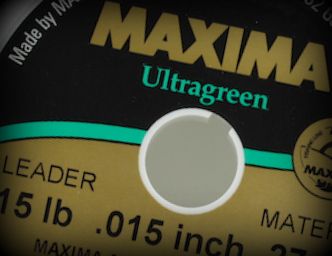
Normal practice is to make the first part of the butt section approximately sixty percent the thickness of the end of the fly line. This equates to about .021 of an inch or a breaking strain of around thirty pounds depending on the brand.
A lot of anglers still attach the indicator to the end of the fly line so even if you gradually stepped down the leader material diameter until you reached the tippet there would still be a significant amount of fairly thick line below the surface.
This not only slows the nymphs descent but also causes more drag during the drift. 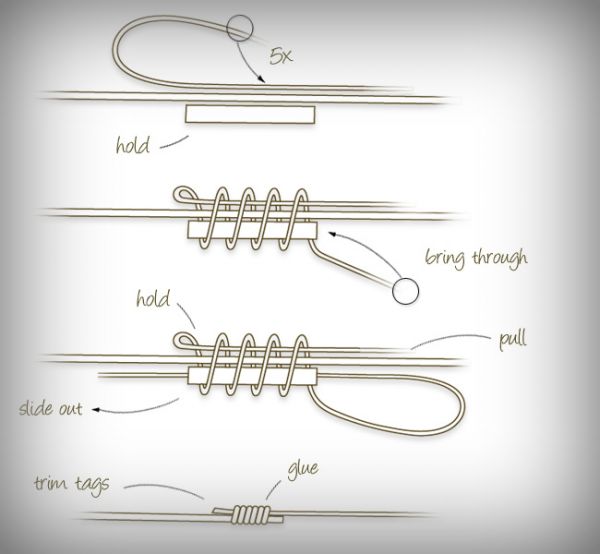
A better solution is to construct a leader that is a bit of a compromise and I find this one works well. The butt is 5ft of 15 lb bs Maxima with a loop tied on one end. Attach this to the fly line with a loop to loop connection. If your fly line doesn't have a welded loop use a nail knot or some other method.{ scroll over diagram }
Tie a small swivel on the other end, this provides a convenient connection point for the rest of the leader and also helps the leader to begin sinking. This thicker section also carries the sliding indicator ... plenty of info on the site about these. www.tongarirofishingguide.co.nz To the other end of the swivel attach approximately 8 ft of 8lb bs Maxima, tie on your flies and that's it.
The reason I don't make the entire leader out of eight pound is because without the thicker butt you get a hinging effect which causes problems and 15 lb was about as light as
I could go without everything landing in a heap. Diagram courtesy of www.loclouds.com
Throughout the day as you move from from spot to spot you'll be fine tuning the depth. For much of the time it will be set around 8ft - 10ft so there will be very little thicker line below the surface, unless you're fishing deep pools. This combined with some of the other measures we've talked about will help your flies sink faster, get them down deep and make it easier to keep them there longer ... which means you should be covering more fish.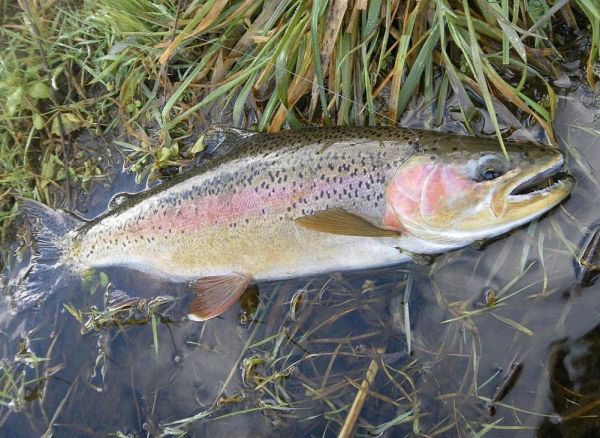 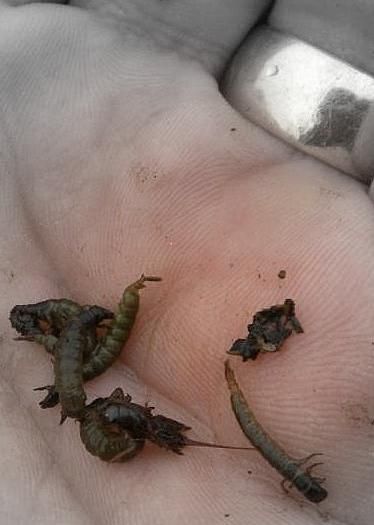
Quite a busy weekend especially Saturday and I counted nine vehicles when I got back to Red Hut car park in the afternoon. Things seem to have quietened down a bit since then unless your a fan of the Bridge pool. The TLB is ticket only now and last time I looked they even had a picnic table and chairs set up.
Still heaps of green caddis in the river and
I picked these off the first small rock I turned over in Judges. There are also some pretty big nymphs around, if you're finding things a bit slow try going up a size.
There's not much of the Braids left but don't ignore it completely. I had a few jacks there earlier in the week and when I hooked the one above ... for a minute or two I thought I was into a really good fish. But if you look closely you can see its hooked in the head.
We need some of the wet stuff to really get things moving. Most of the trout I've caught have been well mended fish that have been around for a while. But with rain or showers forecast for the next few days you never know. 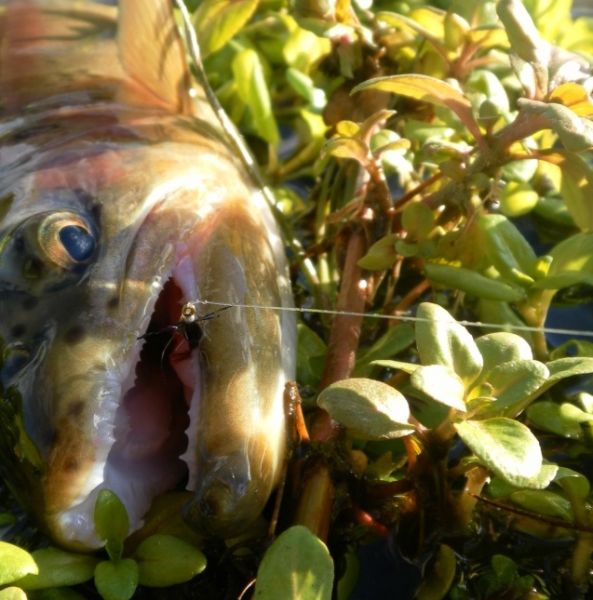
Tight lines guys
Mike |
|
|
| Back to Top |
|
|
|
|
|
|
|